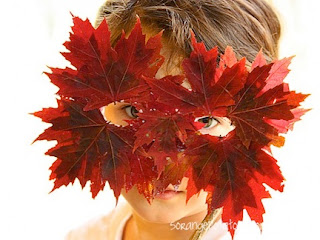A recent workshop making Autumnal Masks was a complete success... We used paper plates that had been pulled from the recycling bin, a couple of bags of fallen leaves, scissors, glue and a bit of elastic to make fantastic masks...
BUT
... what came from making the masks was amazing new characters with personalities as completely different as each mask themselves.... One wee lad when asked about who he now was with his mask on hunched his shoulders over and began stomping like a troll.... he made gobbled gloopy sounds and low growls ...... by complete contrast his sister was whimsically flitting around eminating fairy magic and singing lalalalala - The Smurfs theme song....
ALSO
... we had alot of discussions around the different trees that the leaves come from, the difference between evergreen and deciduous, native trees as opposed to exotic trees and many other questions and answers from workshop hosts, parent, children and the odd teen....
Kids workshops focussed between the ages of 4-12 years. Teaching skills, inspiring innovation & creative questioning, allowing opportunities for caregiver & child problem solving.
Thursday, April 11, 2013
Sunday, March 31, 2013
Props & Free Play Innovations
This Sunday just been our workshop was based around playing with Skittles and Hoops - I also bought down chalk and oggi boards. Often during this type of workshop I am quite hands-on with engagement and encouragement, however this weekend we had quite a different group - they got straight into it and played, they also wanted to stick around for longer which meant that games were adapted and new games were created from the gear provided.
Oggi Boards became frisbees, balancing hats, rolling games
Hoola hoops became targets for ball throwing, containment for ball bounce and catch, skipping roles, rolling games, and leaping games.
Skittles became aim focused kicking practice and pattern making.
Chalk is just a free play winner...
But my favourite part of the day was watching families adapt games so they could all play.
But my favourite part of the day was watching families adapt games so they could all play.
 |
| Setting Up |
Tuesday, February 5, 2013
Flying a kite means tying a knot
Kite History
Kites were first developed in approximately 2,800 years ago in China.
In 1750, Benjamin Franklin published a proposal for an experiment to prove that lightning is electricity by flying a kite in a lightening storm.
Kites were also instrumental in the research and development of the Wright brothers when building the first airplane in the late 1800s.
Over the next 70 years, many new kite designs were developed. These included Eddy's tail-less diamond kite, the tetrahedral kite, the flexible kite, the sled kite, and the parafoil kite, which helped to develop the modern hang-gliders.
The period from 1860 to about 1910 became the "golden age of kiting". Kites started to be used for scientific purposes, especially in meteorology, aeronautics, wireless communications and photography.
How Kites Fly
Kites are airfoils
An
airfoil is any object that redirects the flow of air around it. The wings of
airplanes, sails, bird wings, parachutes, and kite are all considered airfoils.
Tension on the
kite is created by the tether (string) that holds the kite to one central place,
such as your hand.
Wind Pressure
or Thrust
Wind Pressure is created by the wind hitting a solid object.
When the wind hits that object and can not continue on its direction it has to
find another way around the object. This creates:
Lift happens
when more of the wind looking for a new direction goes under the kite, thus
lifting the kite in the air. What happens if more of the wind goes over the top
of the kite?
Drag is created by wind
resistance on the kite's surface (and tail). Drag can also result from
turbulence behind the kite pulling the kite back.
Some
Questions
1. How will the ball of paper fall when I drop it?
2. How about the flat sheet of paper?
3. What is the name of the force that pulls the paper down?
4. Why did the pieces of paper act so differently when I
dropped them?
5. Kites are heavier than air. How do they stay in the air?
6. What features help a kite fly?
Subscribe to:
Posts (Atom)






